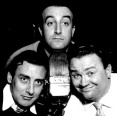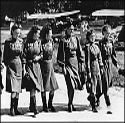|
Speaking of public transport in the States... The author says: quote:For the pedantic rail enthusiasts, the definition of a subway used here is "a network containing high capacity grade-separated passenger rail transit lines which run frequently, serve an urban core, and are underground for at least part of their downtown route." For the rest of you, the definition is "an underground train in a city."
|
|
|
|

|
| # ? Apr 28, 2024 06:40 |
|
I've just finished reading through all 203 pages of this thread and it is fantastic. It's always great to see someone who loves what they do! I recently had a look at the Queensland (Australia) MUTCD and on page 41 of Part 14: traffic signals it has a list of signs that are not approved for use in Queensland:  From these signs that are not approved for use the first one (Traffic light stop sign) is quite perplexing. I can see why it's not approved for use however I'm struggling to think of a situation in which it may have been used. Any thoughts?
|
|
|
|
cheese-cube posted:I've just finished reading through all 203 pages of this thread and it is fantastic. It's always great to see someone who loves what they do! Stop signs are mostly unambiguous, but they're rarely the most efficient way to handle traffic. I can think of some cases where that sign could be useful, if it weren't confusing: - Alternating one-way situations where there's poor sight distance between stop bars. - Isolated pedestrian crossings where traffic must stop and wait for a certain time before proceeding when a ped is present. - Locations where the signal frequently goes dark for whatever reason, to emphasize that it's to be treated as a stop sign when not working. - Anywhere we'd stick a "three at a time" plaque below a stop sign. - At-grade rail crossings at a stop-controlled intersection that require pre-emption (that enough hyphens?) There are better options for each of these, which is probably why the sign's not allowed.
|
|
|
|
Cichlidae posted:Stop signs are mostly unambiguous, but they're rarely the most efficient way to handle traffic. I can think of some cases where that sign could be useful, if it weren't confusing: Wow that was a quick reply! Those usage scenarios make sense and I think that the mention of said sign in the QLD MUTCD is really just a legacy thing (Of course I'm actually in Western Australia although I've never seen any signs like that here). Another question: what's your opinion of variable speed zones? Back in August 2009 Main Roads Western Australia implemented a variable speed zone along a portion of Beaufort Street (Which links the suburbs between Northbridge and Morley to the CBD): https://www.mainroads.wa.gov.au/BUILDINGROADS/PROJECTS/URBANPROJECTS/Pages/Beaufort.aspx As the site above states the variable speed signs will limit traffic to 40 km/h on Sunday to Thursday between 7.30 am - 10.00 pm and Friday to Saturday between 7.30 am - 1.00 am. Outside of these times the speed limit is increased to the designed limit of 60 km/h Their reasoning for implementing the variable speed zone is to reduce accidents involving pedestrians. The area in which they deployed the zone does experience a fairly high level of foot-traffic due to the retailers, pubs and restaurants located along the road as well as the close proximity to Edith Cowan University/Western Australia Academy of Performing Arts (The area is basically hipster-central). You can see one of the signage locations here on Google Maps Street View:  So what do you think of the idea? Has this concept ever been implemented in the US/elsewhere?
|
|
|
|
cheese-cube posted:I've just finished reading through all 203 pages of this thread and it is fantastic. It's always great to see someone who loves what they do! At least as far as the states: if an intersection is having technical issues, the lights will just flash red which means treat it like a 4 way stop. The stop sign would just be reinforcing that idea, although in a really confusing manner. Cichlidae posted:There are better options for each of these, which is probably why the sign's not allowed. It's also confusing as gently caress.
|
|
|
|
My hometown has switched to variable speed zones for all school zones and it seems pointless and confusing. Most zones are 40km/hr normally and 30km/hr during school hours from September to June. They aren't electronic signs so there's a big mess of confusing text on the signs. I think it's more hassle than it's worth for only 10km/hr.
|
|
|
|
EngineerJoe posted:My hometown has switched to variable speed zones for all school zones and it seems pointless and confusing. Most zones are 40km/hr normally and 30km/hr during school hours from September to June. They aren't electronic signs so there's a big mess of confusing text on the signs. I think it's more hassle than it's worth for only 10km/hr. The school one block over from me has a sign that has flashing lights that says 20 mph. It implies that when it's not flashing that the speed limit is something other than 20 mph. The funny thing is, though, is right behind it is another sign says 20 mph without flashing lights. The road is always 20 mph. At first it seemed redundant when I moved here, but after driving that road for a couple months I've found that most people drive 35-40 on this road, so I guess the flashing lights were necessary to get people to slow down to 20 when they need them to. They also almost never stop at the stop sign coming from the little housing area that branches off there (Where I live, I don't know if it's considered a suburb or not.). Almost had someone run into me because they ran it. 
|
|
|
|
cheese-cube posted:I've just finished reading through all 203 pages of this thread and it is fantastic. It's always great to see someone who loves what they do! Sucks to be sitting at a light with no cars in sight yet still be stuck sitting there.
|
|
|
|
grover posted:More intersections should permit left turn (or straight) on red after stopping. Remember that a left turn in Australia doesn't cross any traffic. Also, hook turns are hilarious.
|
|
|
|
nm posted:Remember that a left turn in Australia doesn't cross any traffic. I still think we need more left turn on red allowance in the US.
|
|
|
|
cheese-cube posted:So what do you think of the idea? Has this concept ever been implemented in the US/elsewhere? There are a few different implementations here. The aforementioned school zones typically have a reduced speed when flashing, and draw some attention, probably improving safety for pedestrians but incrementally reducing it for drivers due to a higher risk of rear-ends. Your location sounds pretty similar. In any conflict between a pedestrian and a car, the car's going to win, so if you've got a significant chance that peds will be in the road, lower speeds are the way to go. Another use for variable speed limits is like they do on the Jersey Turnpike (or was it the Garden State?) and the Autobahn, where the limit changes to reflect conditions such as weather and congestion. grover posted:I still think we need more left turn on red allowance in the US. Some states (like Connecticut) allow RTOR by default, unless signed otherwise. Others forbid it, unless signed otherwise, which seems like a tremendous waste of either signs or time.
|
|
|
|
In Europe, right turn on red is typically not allowed. This can be because the separate bicycle path to the right can have a different green time. Or, as is the case more often, because they are afraid you will run into a car coming from another direction and also going to your right. There are a few exceptions. In my country there's a sign that allows only bicycles to turn right on red. But I don't think it's ever allowed for cars, anywhere in Europe. So that was quite confusing when I first visited the USA. We kept waiting for a green light when we were in the front and going to go right. At least, the people waiting behind us seemed more patient that European car drivers.
|
|
|
|
It's allowed in Germany, although only at some junctions and they're signposted pretty clearly. http://www.fulda.de/?id=1698
|
|
|
|
Cichlidae posted:Some states (like Connecticut) allow RTOR by default, unless signed otherwise. Others forbid it, unless signed otherwise, which seems like a tremendous waste of either signs or time.
|
|
|
|
Right turns on red only block one other movement, straight on red and left on red both block two other movements.
|
|
|
|
... not if there are no other vehicles present...
|
|
|
|
grover posted:Yes, plenty of states allow RTOR. But I'd love to also see LTOR and straight on red. Basically, being able to treat a red light like a stop sign and proceed if safe to do so. Why can't we do that more places? I think it would make a lot more sense to just turn signals into blinking reds during off-peak hours.
|
|
|
|
Chaos Motor posted:... not if there are no other vehicles present... Movements are still blocked even when there's no other vehicle around that's trying to execute them! Anyway, it's not like anyone's going to catch you if there really are no other vehicles around where you want to turn on red. 
|
|
|
|
Mandalay posted:I think it would make a lot more sense to just turn signals into blinking reds during off-peak hours.
|
|
|
grover posted:Even during peak hours, there are often large breaks in traffic. Frustrating to not be able to use them. Sure, smarter lights might be able to recognize this and change, but drivers could do the same thing. Think of how many people already run right-on-red. Now imagine this crossing oncoming traffic. This is why we can't have nice things.
|
|
|
|
|
ConfusedUs posted:Think of how many people already run right-on-red. Basically this. The first two lawsuits would eliminate any savings you got.
|
|
|
|
Sometimes I think insurance rates should be higher for people who get into accidents, to keep lovely drivers off the road.
|
|
|
Mandalay posted:Sometimes I think insurance rates should be higher for people who get into accidents, to keep lovely drivers off the road. That already happens. Insurance companies love to gouge you when you get a ticket or are in a wreck that is your fault. My wife had a wreck, her fault, and our insurance went up 25%
|
|
|
|
|
Mandalay posted:Sometimes I think insurance rates should be higher for people who get into accidents, to keep lovely drivers off the road. How, uh, do you think car insurance works?
|
|
|
|
I mean higher than they are now. Like way higher.
|
|
|
|
Mandalay posted:I mean higher than they are now. Like way higher. In practice that will produce a lot of lovely drivers who now are driving illegally without insurance, but will still be there crashing into you.
|
|
|
|
Install Gentoo posted:In practice that will produce a lot of lovely drivers who now are driving illegally without insurance, but will still be there crashing into you. Indeed. Around 1 in 7 drivers in the US are already uninsured. In a few states it's around 1 in 4 http://usatoday30.usatoday.com/news/nation/story/2011-09-11/uninsured-drivers/50363390/1
|
|
|
|
Is there an optimal separation distance for bus stops? I rode the bus in downtown LA and stops are within two or three minutes walking distance of each other. A trip that would normally take five minutes driving would take fifteen minutes even when the bus can skip a few stops. Here's a google maps link because the other map doesn't have a scale bar. The diagonal distance is a bit over one mile.
|
|
|
|
mamosodiumku posted:Is there an optimal separation distance for bus stops? I rode the bus in downtown LA and stops are within two or three minutes walking distance of each other. A trip that would normally take five minutes driving would take fifteen minutes even when the bus can skip a few stops. As an example of what kind of effect bad stop spacing can have on transit: We recently pulled a ton of bus stops in Tampa (including the ones in front of my apartment Varance fucked around with this message at 03:10 on Apr 10, 2013 |
|
|
|
mamosodiumku posted:Is there an optimal separation distance for bus stops? I rode the bus in downtown LA and stops are within two or three minutes walking distance of each other. A trip that would normally take five minutes driving would take fifteen minutes even when the bus can skip a few stops. People are generally willing to walk 1/4 mile to the nearest bus stop. In an ideal corridor, that leads to 1/2 mile stop spacing. In practice, it varies a bit, because you're dealing with a road grid that might not adhere to that kind of spacing, and there may be big attractors (like a college campus, for example) which have more stops than they strictly need. If ridership's high enough, adding extra bus stops seems like a simple way to reduce crowds at heavily used stations, but its effect is debatable as it actually increases the time buses have to spend on the route.
|
|
|
|
grover posted:Yes, plenty of states allow RTOR. But I'd love to also see LTOR and straight on red. Basically, being able to treat a red light like a stop sign and proceed if safe to do so. Why can't we do that more places? This sounds like something that would be nice have in a bizarre way, as for some unknown reason the I-10 under/overpass lights in Tucson will often not have a left turn signal during the middle of the day, to the point of one morning coming back home from class I saw 2 or so accidents almost happen because people got fed up waiting to make a left onto the 10/frontage road and just gunned it on the yellow or the red itself after waiting 3-4 cycles.
|
|
|
|
We don't have any "turn on red" rules in the UK at all, unless the turn is somehow filtered in its own lane, the junction needs making especially for it. I don't know how best to describe it. But at a regular crossroads or something? Not a chance.
|
|
|
|
thehustler posted:We don't have any "turn on red" rules in the UK at all, unless the turn is somehow filtered in its own lane, the junction needs making especially for it. I don't know how best to describe it. What I remember about Europe was that they have many fewer lights and stop signs than North America. There's plenty of places in North America where we have traffic lights, yet it's incredibly safe to turn into the curb lane on red (right on red, or left on red on certain intersections of one-way streets) because traffic is so light for the majority of the day. Now, the real reason I came here: I read a report on the news today that apparently pedestrian count-down timers are increasing pedestrian safety but also causing more car accidents in the intersection because cars are using the pedestrian countdowns to know when they need to speed up, or maybe stop (note: in many cases, the pedestrian signal and traffic signal are on different cycles). Now, having been to countries where they have countdown timers on traffic lights (both red and green): why don't we just add those? You'll have fewer people accidentally running yellow lights, you'll know when to put your car in gear at a red light, etc. Yet for some reason, I haven't ever seen one in North America. What are your thoughts on the use of countdowns for pedestrians, traffic lights, or both?
|
|
|
|
mamosodiumku posted:Is there an optimal separation distance for bus stops? I rode the bus in downtown LA and stops are within two or three minutes walking distance of each other. A trip that would normally take five minutes driving would take fifteen minutes even when the bus can skip a few stops. Varance posted:As an example of what kind of effect bad stop spacing can have on transit: This already exists in LA - see the Metro Rapid lines (numbered route 7XX): http://www.metro.net/projects/rapid/ Key Metro Rapid Attributes: Simple route layout: Makes the system easier to use and remember routes Frequent service: Buses arrive as often as every 3-10 minutes during peak commute times Fewer stops: Stops are spaced about ¾ mile apart, like rail lines, at most major transfer points Level boarding/alighting: Low-floor buses speed-up dwell times Bus priority at traffic signals: this technology reduces traffic delay at intersections by extending the green light or shortening the red light Color-coded buses and stops: Metro Rapid's distinctive red color scheme makes it easy to identify Metro Rapid stops and buses Enhanced stations: Metro Rapid stations provide transit information, lighting, canopies and "Next Bus" displays
|
|
|
|
Speaking of bus priority systems... My city spent millions on such a system, then did nothing with it. The city installed it, not the transit company. The transit company then didn't want to spend the money to install what was needed on the buses. Finally they did but never activated them. They did a bit of testing and found it had absolutely no increase in efficiency and a mild increase in traffic back-ups around the lights effected. Finally like 5 years later this became public and everyone got upset we had this technology but weren't using it, then mad when it came out it wasn't useful. Then the city/transit company said they can't use it anyways since the technology is now out of date and to correctly implement it they'd have to start over from scratch. No one was fired over it.
|
|
|
|
PT6A posted:What I remember about Europe was that they have many fewer lights and stop signs than North America. Yes, that is true I think. Instead of traffic light intersections there are many roundabouts as well. Most countries have a clear system of roads having priority/right of way over other roads. This in turn means that many traffic lights and stop signs can be replaced by yield signs on one road and 'you have right of way' signs on the other. Yield means drivers don't have to stop unless they see traffic coming their way, which means it saves drat expensive fuel compared to stop signs. Stop signs are ONLY used in cases where drivers can't see the intersecting road properly.
|
|
|
|
Last time showed examples of semi-complicated yield signage near my house people in this thread were asking how there aren't a million accidents. Y'all are control freaks.
|
|
|
|
Carbon dioxide posted:This in turn means that many traffic lights and stop signs can be replaced by yield signs on one road and 'you have right of way' signs on the other. I'm not seeing what the point of the right of way signs are, in America an intersection like that would generally have no signage at all on the higher priority road.
|
|
|
|
Koesj posted:Last time showed examples of semi-complicated yield signage near my house people in this thread were asking how there aren't a million accidents. Y'all are control freaks. No, our drivers are just painfully loving stupid. Even yield signs are dangerous because you can never assume the person ahead of you is going to go just because there's no traffic and the light is green anyway.
|
|
|
|

|
| # ? Apr 28, 2024 06:40 |
|
Carbon dioxide posted:This in turn means that many traffic lights and stop signs can be replaced by yield signs on one road and 'you have right of way' signs on the other. What's this yield you speak of? Oh those triangle signs? They mean just keep going and just to be aware someone is about to move over but it's you option to just keep driving, right?
|
|
|




































